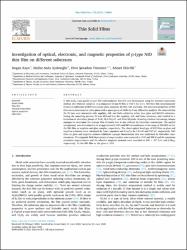| dc.contributor.author | Aydınoğlu, Hafize Seda | |
| dc.contributor.author | Kaya, Doğan | |
| dc.contributor.author | ŞenadımTüzemen, Ebru | |
| dc.contributor.author | Ekicibil, Ahmet | |
| dc.date.accessioned | 2022-05-17T11:53:39Z | |
| dc.date.available | 2022-05-17T11:53:39Z | |
| dc.date.issued | 31 August 2021 | tr |
| dc.identifier.citation | D. Kaya, H. S. Aydınoğlu, E. Şenadım Tüzemen, A. Ekicibil, Investigation of optical,
electronic, and magnetic properties of p-type NiO thin film on different substrates, Thin Solid
Films 732 (2021) 138800, https://doi.org/10.1016/j.tsf.2021.138800 | tr |
| dc.identifier.issn | 0040-6090 | |
| dc.identifier.uri | https://hdl.handle.net/20.500.12418/13186 | |
| dc.description.abstract | In this study, high-quality p-type NiO semiconductor thin film was investigated using the thermal evaporation
method after thermal oxidation of as-deposited 50 nm Ni film at 450◦C for 2.5 h. NiO thin film simultaneously
formed on substrates of different nature; glass, sapphire, Si(100), InP, and GaAs. The structural properties of NiO
films were determined as cubic phase with a space group of Fm3m by X-ray diffraction analysis. We observed that
the Ni ions were interacted with sapphire, InP, and GaAs substrates rather than glass and Si(100) substrates.
During the annealing process, Ni ions diffused into the sapphire, InP, and GaAs substrates, and resulted in a
formation of secondary phases of NiAl, NixP/Ni2InP, and NiAs/Ni2GaAs. Scanning electron microscopy images
managed to determine the average film thickness that is also affected by Ni-surface interactions. The optical
transparency was determined to be at approximately 94% and 89% transmittance in the range of 300-800 nm for
the NiO film on sapphire and glass samples, respectively. The direct optical band gap of NiO films on glass and
sapphire substrates were calculated by Tauc’s equation and found to be 3.63 eV and 3.67 eV, respectively. NiO
films on glass and sapphire surfaces exhibited a p-type characteristic that was confirmed by Hall-effect mea-
surements. The magnetic field dependence of magnetization was measured at 10 K and 300 K and the maximum
saturation magnetization and the effective magnetic moment were recorded as 245 × 103 A/m and 2.58μB,
respectively, for the NiO film on the glass at 10 K. | tr |
| dc.language.iso | eng | tr |
| dc.publisher | Elsevier | tr |
| dc.relation.isversionof | https://doi.org/10.1016/j.tsf.2021.138800 | tr |
| dc.rights | info:eu-repo/semantics/openAccess | tr |
| dc.subject | Nickel Oxide, Thin film, Thermal evaporation, Optical properties, Hall-effec | tr |
| dc.title | Investigation of optical, electronic, and magnetic properties of p-type NiO thin film on different substrates | tr |
| dc.type | article | tr |
| dc.relation.journal | Thin Solid Films | tr |
| dc.contributor.department | Sağlık Hizmetleri Meslek Yüksekokulu | tr |
| dc.contributor.authorID | 0000-0003-0416-8276 | tr |
| dc.identifier.volume | 732 | tr |
| dc.relation.publicationcategory | Uluslararası Hakemli Dergide Makale - Kurum Öğretim Elemanı | tr |















